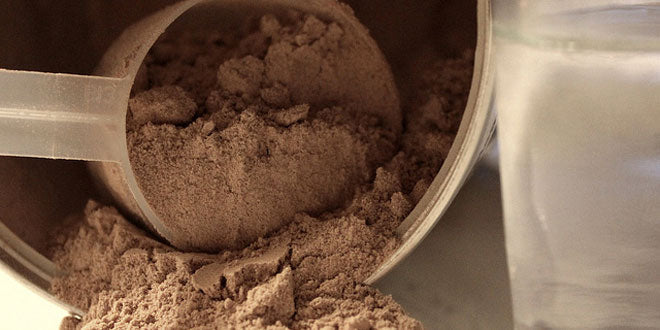By Jenna Corbin, MS, RD, LD, CSSD, CLT, PES, CESProtein Powder in the Bigger PictureTake the quiz now for 1 SPIN® CEC Protein powder supplementation has been a common practice in the fitness industry for decades, particularly in the bodybuilding community; but it is growing in popularity among other groups such as the weight loss population (as meal replacement) and even in critically ill patients who need extra nutrient-dense calories (e.g., cancer or immunosuppressed patients). The food industry has responded to consumer demand by manufacturing a variety of protein powder products to meet the diverse needs of today’s health-aware demographic. Consequently, it has become increasingly difficult to select the best protein powder product for a given objective because the numerous options available. With all the different types of protein powders out there, the question often becomes “which is best?” There’s technically no right answer, as it will depend on individual goals, beliefs, tolerance, preference and taste. Even the “best” protein powder isn’t going to be very beneficial if it cannot be stomached.Protein is a nutrient of particular interest after training and throughout the day because it is critical for optimizing protein synthesis (to repair muscle tissue and optimize muscle mass). However, protein is not the only important focus for daily and post-exercise nutrition. Adequate total calorie, macro- and micronutrient intake around training and throughout the day should also be prioritized.Thus, an effort should be made to obtain protein requirements through whole food because it provides synergistic nutrients in the “whole package”. This helps contribute to overall dietary variety and diversity and provides the body with a broad spectrum of nutrients (macronutrients, micronutrients and phytochemicals). If ‘nutrient timing’ after a workout is of concern, remember in most cases there is up to a 1-2 hour window of time to optimally replenish nutrient stores—so a whole food-based meal is feasible in most circumstances. Plus, consistent and adequate intake throughout the remainder of the day may be just as important, if not more.However, tolerance issues, time and convenience may make protein powders a more practical option. They can be used to make shakes or smoothies, mixed into foods such as hot or cold cereals, yogurt, cottage cheese or even used in a variety of ways when baking or cooking (homemade snack bars, muffins, pancakes, granola, etc.). The options are endless and supplementing with extra protein is a great way to boost any foods’ protein content. With that said; let’s explore some of the options available.
Protein Powder 101 Protein powders can come from both animal and plant sources; including animal sources such as dairy (whey and casein) and egg; and plant proteins such as soy, rice, hemp, and pea. Within each source may be different types of powder—concentrate, isolate, or hydrolyzed--that are classified based on differences in processing.In a general and simplified sense, protein isolates are a more “pure” source of a protein since more protein has been extracted and purified out from the original source (animal or plant). An isolate is made up of at least 90% protein. A concentrate is less purified from the original source, and thus has a greater amount of other substances (namely carbohydrate and fat). Finally, hydrolyzed protein has been enzymatically treated to partially pre-digest it, which reportedly helps ease and hasten its digestion and assimilation by the body.The major marker of quality and usefulness of protein powders is their bioavailability—expressed as their amino acid composition (amount and variety) and how well they are digested, assimilated and utilized by the body after ingestion (with ultimate delivery to target tissue). There are various methods used to determine the quality of the different proteins (Biological Value, Net Protein Utilization, Protein Efficiency Ratio, and Protein Digestibility Corrected Amino Acid Score or PDCAAS), with PDCAAS being considered the most precise and commonly used of those currently available. Whey and egg protein rank the highest among all the methods, while whey, casein, egg, and soy protein all have PDCAAS of “1” on a scale of “0-1”. All other known plant-based proteins have PDCAAS lower than 1.Regardless of the classification system utilized, however, protein quality ultimately depends on its amino acid profile. Complete protein sources that contain the greatest amounts of essential amino acids generally have higher protein quality. Whey Protein:For a variety of reasons, whey protein is currently the most popular source marketed to active individuals and athletes. It’s one of the two milk proteins, comprising ~20% of the protein in milk. Like all animal proteins, it’s considered a complete protein—containing all of the essential amino acids in adequate amounts to meet currently suggested requirements for physiologic needs. Not only is it digested and assimilated quickly (considered a “fast” protein source), it contains high levels of the essential and branch chain amino acids—particularly leucine. As a result, it possesses special anabolic properties (muscle building) and has been shown to increase muscle protein synthesis to a greater extent than other types of protein. It has also generally been reported to be one of the better tasting and easier to use protein powders.Even though whey does have some pretty impressive properties, it isn’t the only option for a quality protein supplement. Depending on tolerance, beliefs or preferences, trying one of the following alternate options may be appropriate.
Whey Protein:For a variety of reasons, whey protein is currently the most popular source marketed to active individuals and athletes. It’s one of the two milk proteins, comprising ~20% of the protein in milk. Like all animal proteins, it’s considered a complete protein—containing all of the essential amino acids in adequate amounts to meet currently suggested requirements for physiologic needs. Not only is it digested and assimilated quickly (considered a “fast” protein source), it contains high levels of the essential and branch chain amino acids—particularly leucine. As a result, it possesses special anabolic properties (muscle building) and has been shown to increase muscle protein synthesis to a greater extent than other types of protein. It has also generally been reported to be one of the better tasting and easier to use protein powders.Even though whey does have some pretty impressive properties, it isn’t the only option for a quality protein supplement. Depending on tolerance, beliefs or preferences, trying one of the following alternate options may be appropriate.
Casein ProteinCasein makes up the other ~80% of protein in milk, and is considered a “slow” protein due to the rate of digestion and delivery of amino acids to the body. Therefore, casein protein is suggested to be a good option for those looking to increase satiety throughout the day. It is also speculated to be the best protein option at night (to minimize any muscle losses throughout the nightly “fast”) again due to its “slow” properties. This is purely anecdotal at this point, and in fact other proteins (such as whey) or a mix of proteins (whole food) are good choices as well—especially in the interest of variety.
Egg ProteinEgg protein, most often found in the form of egg white powder, is not as popular a powder as whey or casein—possibly related to taste. Nevertheless, it is still a very high-quality, complete protein that has a medium rate of digestion and delivery. Egg white protein powders are a good alternative for those who cannot consume soy or dairy and can be used similar to whey in shakes, baking/cooking, or added to foods. This may be an especially good case to consume the whole food (egg) due to its rich nutrient content beyond just protein (i.e., micronutrients) and functional food properties.
Soy Protein Soy protein is a plant-based protein that is generally considered complete based on its amino acid profile and also has a medium rate of digestion and delivery. As a protein powder, it can be found in both concentrate and isolate forms. It does not have as high of leucine content ounce-for-ounce as animal proteins, especially whey, and thus is not as efficient of a protein source for muscle protein synthesis. Soy is also high in isoflavones, which are compounds that have potential estrogen-like effects on the body. So although there are some possible hormonal concerns with soy protein, especially in isolated powders and with high consumption, much of the concern regarding soy’s estrogenic or ‘feminizing’ effects appear to be overstated. Regardless, the general recommendation is not to consume too much soy protein, staying around ~25g/day—especially for men or those with hormone balance concerns. Try to choose whole food-based soy options as much as possible (whole soybeans, miso, soy milk, tofu and tempeh).
Additional Plant-Based Proteins: Rice, Hemp, and Pea The protein portion of rice (PDCAAS ~0.47), hemp (PDCAAS ~0.48) and pea (PDCAAS ~0.69) is extracted to create powders that are plant-based, so they are ideal for those looking for vegetarian or vegan options, or with allergies or intolerances to milk or soy--although they’re good alternative options for anyone. These proteins are often labeled as “incomplete” since as a natural, independent source they have inadequate amounts of at least one essential amino acid to meet requirements. However, incorporating various plant-based proteins into a balanced, well-rounded diet can ensure all essential amino acid needs are met. One thing to note, tastes of these various protein powders can vary and are often acquired. Typically, rice, hemp, and pea proteins are higher in carbohydrate (and fat, especially in the case of hemp) with a lower overall protein content. As a result, more total protein powder would need to be consumed in order to get the same amount of essential amino acids and beneficial physiologic effects as animal-based powders.One last word of caution, no matter what type of protein powder you choose, make sure it comes from a trusted, reputable company. And preferably is third-party tested for quality and purity—to increase confidence that is has in it what it says it has, and doesn’t have anything it doesn’t say it has. Read the label and choose a product with as few “extra” ingredients as possible—the closer it is to having just “protein” on the label the better.Protein powders are not a necessity in order to reach health and performance goals, and the first go-to strategy should in fact be a whole-food based meal as much as possible. However, a variety of factors may not make this most practical. Choosing alternatives, such as a protein powder, can help fill in the gaps and meet needs within the context of an overall, sound training and nutrition plan. Although whey protein is often touted as the “best” choice for a protein powder, there are actually many options that are good, high-quality choices. What specific protein powder one chooses to use should be based on individual preferences, beliefs, schedule, goals and needs. In the interest of variety, quality, and effectiveness, it in fact wouldn’t be a bad idea to try-out and appropriately incorporate various types of protein powders in a well-balanced, whole food-based plan.Jenna has an undergraduate degree in Foods & Nutrition and a Master’s degree in Human Movement. She is a Registered/Licensed Dietitian and Certified Specialist in Sports Dietetics. She has experience working with a variety of individuals from children to professional athletes.Take the quiz now for 1 SPIN®
CECReferences: Aragon, Alan and Schoenfeld, Brad. “Nutrient timing revisited: Is there a post-exercise anabolic window?” Journal of the International Society of Sports Nutrition, 10, no. 5 (2013): 1-11.Campbell, Bill et al. “International Society of Sports Nutrition Position Stand: Protein and Exercise.” Journal of the International Society of Sport Nutrition, 4, no. 8, (2007).Hoffman, Jay and Falvo, Michael. “Protein—Which is Best?” Journal of Sports Science and Medicine, 3, no. 3, (2004): 118-130.House, James, Neufeld, Jason, and Leson, Gero. “Evaluating the quality of protein from hemp seed (Cannabis Saliva L.) products through the use of the Protein Digestibility Corrected Amino Acid Score method.” Journal of Agriculture and Food Chemicals, 58, no. 22, (2010): 11801-11807.Kerksick, Chad et al. “International Society of Sports Nutrition Position Stand: Nutrient Timing.” Journal of the International Society of Sports Nutrition, 5, no. 17, (2008).Kreider, Richard et al. “ISSN exercise & sports nutrition review: research & recommendations.” Journal of the International Society of Sports Nutrition, 7, no. 7, (2010): 1-93.Lowery, Lonnie, Edel, James, and McBride, Isaiah. “Dietary Protein and Strength Athletes.” Strength and Conditioning Journal, 34, no. 4, (2012): 26-32.Schaafsma, Gertjan. “The Protein Digestibility-Corrected Amino Acid Score.” The Journal of Nutrition, (2000): 1865S-1867S.Schaafsma, Gertjan. “The Protein Digestibility-Corrected Amino Acid Score (PDCAAS)—a concept for describing protein quality in foods and food ingredients: a critical review.” The Journal of AOAC International, 88, no. 3, (2005): 988-994.Schoenfeld, Brad, Aragon, Aaron, Krieger, James. “The effect of protein timing on muscle strength and hypertrophy: A meta analysis.” Journal of the International Society of Sports Nutrition, 10, no. 53 (2013).Wein, Debra, and Carter, Ashley. “Food vs. Supplements for Optimal Nutrition.” NSCA’s Performance Training Journal, 11, no. 4, (2012), 44-46.





Leave a comment
This site is protected by hCaptcha and the hCaptcha Privacy Policy and Terms of Service apply.